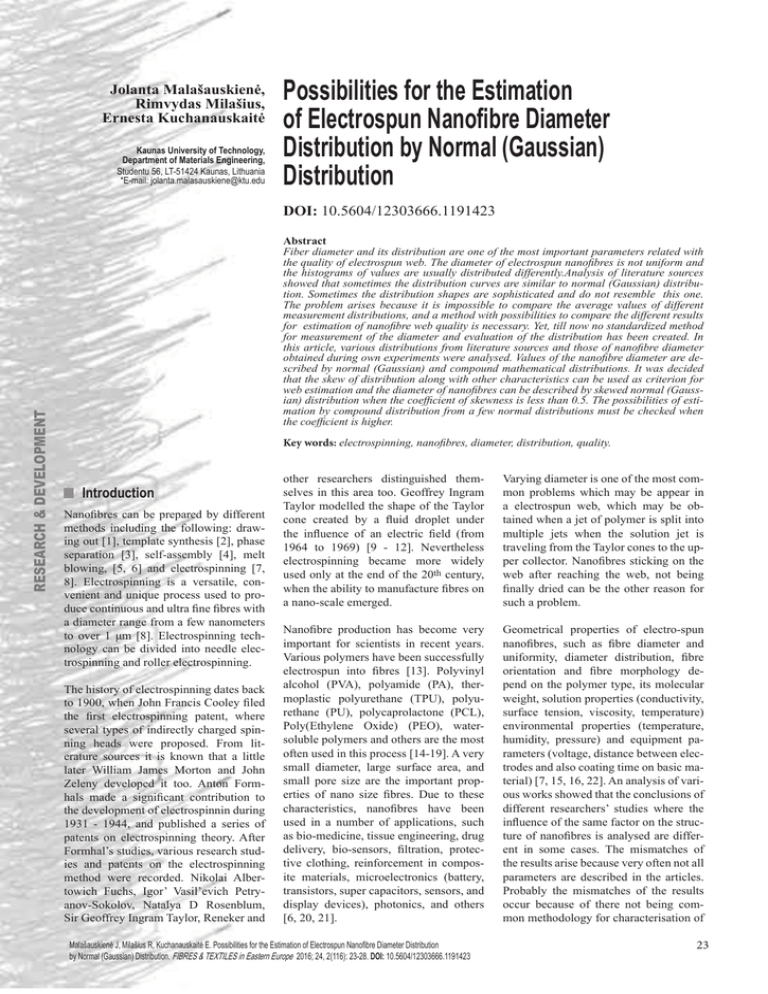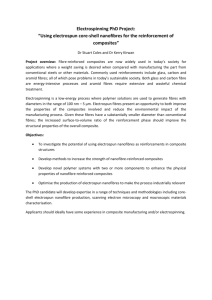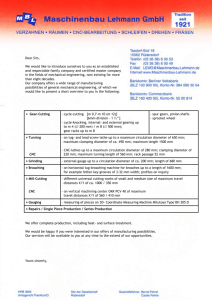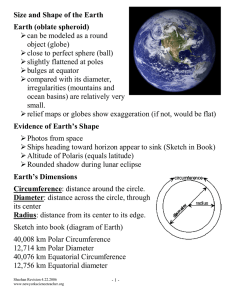Possibilities for the Estimation of Electrospun Nanofibre Diameter Distribution by Normal (Gaussian) Distribution
advertisement

Jolanta Malašauskienė, Rimvydas Milašius, Ernesta Kuchanauskaitė Kaunas University of Technology, Department of Materials Engineering, Studentu 56, LT-51424 Kaunas, Lithuania *E-mail: jolanta.malasauskiene@ktu.edu Possibilities for the Estimation of Electrospun Nanofibre Diameter Distribution by Normal (Gaussian) Distribution RESEARCH & DEVELOPMENT DOI: 10.5604/12303666.1191423 Abstract Fiber diameter and its distribution are one of the most important parameters related with the quality of electrospun web. The diameter of electrospun nanofibres is not uniform and the histograms of values are usually distributed differently.Analysis of literature sources showed that sometimes the distribution curves are similar to normal (Gaussian) distribution. Sometimes the distribution shapes are sophisticated and do not resemble this one. The problem arises because it is impossible to compare the average values of different measurement distributions, and a method with possibilities to compare the different results for estimation of nanofibre web quality is necessary. Yet, till now no standardized method for measurement of the diameter and evaluation of the distribution has been created. In this article, various distributions from literature sources and those of nanofibre diameter obtained during own experiments were analysed. Values of the nanofibre diameter are described by normal (Gaussian) and compound mathematical distributions. It was decided that the skew of distribution along with other characteristics can be used as criterion for web estimation and the diameter of nanofibres can be described by skewed normal (Gaussian) distribution when the coefficient of skewness is less than 0.5. The possibilities of estimation by compound distribution from a few normal distributions must be checked when the coefficient is higher. Key words: electrospinning, nanofibres, diameter, distribution, quality. nIntroduction Nanofibres can be prepared by different methods including the following: drawing out [1], template synthesis [2], phase separation [3], self-assembly [4], melt blowing, [5, 6] and electrospinning [7, 8]. Electrospinning is a versatile, convenient and unique process used to produce continuous and ultra fine fibres with a diameter range from a few nanometers to over 1 μm [8]. Electrospinning technology can be divided into needle electrospinning and roller electrospinning. The history of electrospinning dates back to 1900, when John Francis Cooley filed the first electrospinning patent, where several types of indirectly charged spinning heads were proposed. From literature sources it is known that a little later William James Morton and John Zeleny developed it too. Anton Formhals made a significant contribution to the development of electrospinnin during 1931 - 1944, and published a series of patents on electrospinning theory. After Formhal’s stud­ies, various research studies and patents on the electrospinning method were recorded. Nikolai Albertowich Fuchs, Igor’ Vasil’evich Petryanov-Sokolov, Natalya D Rosenblum, Sir Geoffrey Ingram Taylor, Reneker and other researchers distinguished themselves in this area too. Geoffrey Ingram Taylor modelled the shape of the Taylor cone created by a fluid droplet under the influence of an electric field (from 1964 to 1969) [9 - 12]. Nevertheless electrospinning became more widely used only at the end of the 20th century, when the ability to manufacture fibres on a nano-scale emerged. Varying diameter is one of the most common problems which may be appear in a electrospun web, which may be obtained when a jet of polymer is split into multiple jets when the solution jet is traveling from the Taylor cones to the upper collector. Nanofibres sticking on the web after reaching the web, not being finally dried can be the other reason for such a problem. Nanofibre production has become very important for scientists in recent years. Various polymers have been successfully electrospun into fibres [13]. Polyvinyl alcohol (PVA), polyamide (PA), thermoplastic polyurethane (TPU), polyurethane (PU), polycaprolactone (PCL), Poly(Ethylene Oxide) (PEO), watersoluble polymers and others are the most often used in this process [14-19]. A very small diameter, large surface area, and small pore size are the important properties of nano size fibres. Due to these characteristics, nanofibres have been used in a number of applications, such as bio-medicine, tissue engineering, drug delivery, bio-sensors, filtration, protective clothing, reinforcement in composite materials, microelectronics (battery, transistors, super capacitors, sensors, and display devices), photonics, and others [6, 20, 21]. Geometrical properties of electro-spun nanofibres, such as fibre diameter and uniformity, diameter distribution, fibre orientation and fibre morphology depend on the polymer type, its molecular weight, solution properties (conductivity, surface tension, viscosity, temperature) environmental properties (temperature, humidity, pressure) and equipment parameters (voltage, distance between electrodes and also coating time on basic material) [7, 15, 16, 22]. An analysis of various works showed that the conclusions of different researchers’ studies where the influence of the same factor on the structure of nanofibres is analysed are different in some cases. The mismatches of the results arise because very often not all parameters are described in the articles. Probably the mismatches of the results occur because of there not being common methodology for characterisation of Malašauskienė J, Milašius R, Kuchanauskaitė E. Possibilities for the Estimation of Electrospun Nanofibre Diameter Distribution by Normal (Gaussian) Distribution. FIBRES & TEXTILES in Eastern Europe 2016; 24, 2(116): 23-28. DOI: 10.5604/12303666.1191423 23 the structure of nanofibres. Quite often only the average diameter of nanofibres is used for estimation of web quality, while the distribution of measurements is analysed even more rarely. According to changes in the average value, the conclusions of various authors are made about the influence of the parameters on the web structure, which can be one of the reasons for controversial results. The average diameter is very important for estimation of the structure, however only the average value cannot be used for characterisation of the web. From various literature sources, it has been observed that the diameter of nanofibres always distributes differently [5, 8, 18, 19, 23 - 29], and it is very difficult to compare the average values when the distributions of the diameter are different. Very often the changes in the average value do not imply the same changes in the distribution skew or in the width of the distribution. Therefore it is necessary to characterise webs mathematically and evaluate the shape of the distribution obtained. Sometimes the distributions of the diameter are close to the log normal distribution, and various authors have stated that fibre diameter distributions are described well by log-normal functions [5, 19, 27, 28, 30]. However, it is not correct to characterise the diameter of nanofibres by log normal distribution because all nanofibres are made simultaneously in the web. According to classical theory, usually the values of the fibre diameter of various textile materials are spread by normal (Gaussian) distribution [31]. Some authors state that the distribution of nanofibre diameters could be described exactly as normal distribution [23, 24, 32]. The shape of the normal distribution can be described as symmetrical, also right or left skewed. Skew normal distribution is not symmetrical about a central value. The data presented in various literature show that sometimes it is very difficult to comment on the normal and abnormal distribution of diameter values. For this reason, the use of the skewness coefficient as one of the criterion for estimation of web structure is proposed. As was mentioned in previous works [29, 33 - 35], in reality the histograms of fibre diameter are very often far from the normal distribution. Furthermore the measurements are distributed by very complex 24 distributions. The problem arises when it is described as a normal one distribution. The method of compound distribution for estimation of diameter distribution with several peaks was proposed in previous works [29, 33 - 35]. ated on the surface of this roller. A jet of polymer solution is ejected from the Taylor cones when electrostatic forces overcome the surface tension, and is directed up to the support material, which is covered by a layer of nanofibres. Analysis of various distributions of nanofibre diameter as well as comparison and evaluation of the structure of the web by mathematical criteria, but not the causes of results received, are the main goals of the present article. The results presented in this paper, along with previous ones [29, 33 - 35], allow us to evaluate the structure of the web more accurately. The nanofibres web morphology received was analysed by Scanning Electron Microscopy (SEM) – SEM - FEI Quanta 200 (Netherlands). Values of the nanofibre diameter were measured from SEM images by a LUCIA Image 5.0 programme with an accuracy of ± 0.01 nm. The mathematical statistic parameter, i.e. the coefficient of skewness |a|, was used in this article for estimation of the web [31]. It was calculated using the formula: n Materials and methods Some data from literature sources were used for analysis of the present work. The distribution of nanofibres prepared with a combination of poly(D,L-lactide) (PDLLA) and poly(ethylene oxide) (PEO) and that of the cd-PVA nanofibre diameter were chosen for our analysis [18, 25]. The diameter distribution of poly(succinimide) (PSI) nanofibres, distribution of keratin/poly(ethylene oxide) (PEO) nanofibres and that of polyurethane (PU) nanofibres formed by electrospinning and other distributions were used for our investigations [23, 24, 36]. Some parts of the experiments were carried out in our laboratory. The first experiment was carried out for polyvinyl alcohol PVA, where an aqueous PVA solution was diluted using distilled water in order to get 8% concentration of the solution. The distance between elec­trodes during the experiment was 13 cm and the volt­ age applied was 65 kV. The second experiment was carried out for polyamide 6 (PA6). A 15% solution of PA6 in 85% formic acid was gently stirred at ambient temperature for 8 hours. The distance between electrodes during the experiment was 13 cm and the voltage applied was 70 kV. A nonwoven web from PVA and PA6 nanofibres was formed using electrospinning - equipment „NanospiderTM“ (Elmarco, Czech Republic), which is an electrospinning technique requiring the use of a high-voltage electrostatic field in order to create an electrically charged stream of polymer solution. The spinning head in this equipment is a rotating roller partially submerged in a polymer solution. Taylor cones with increasing electrostatic forces are cre- n A= ∑ (x − x ) i =1 i 3 n × s3 where,x is the average diameter of nanofibres, xi the value of the diameter, n the number of measurements, and s is the standard deviation. This coefficient shows the skew of distribution and characterises the shape of the distribution obtained. It is considered that the distribution of measurements is very symmetric when |A| ≤ 0.1, and it is considered that the distribution of measurements is very asymmetric when |A| ≥ 0.5. In this case, it is necessary to check the suitability of the normal distribution for estimation of the web structure [31]. The method of dividing the compound distribution into several normal distributions is presented in previous works [29, 33 - 35]. All normal distributions were calculated according the empirical values, and the compound distribution was calculated by summarising the values of all normal distributions. A high correlation between empirical and calculated values using a compound distribution was established in previous investigations [29]. n Results and discusion There are many studies where empirical distributions of electrospun nanofibres are analysed, some of which are similar to normal (Gaussian) distributions. However, there are studies with a sophisticated distribution of the fibre diameter and types of fibres with an unclear distribution. The diameter distribution of PSI nanofibres from literature sources is presented FIBRES & TEXTILES in Eastern Europe 2016, Vol. 24, 2(116) 30 35 No. of observation 27 30 Percentage of f ibres, % 24 21 18 15 12 9 6 3 180-200 160-180 140-160 120-140 100-120 80-100 60-80 40-60 20-40 0-20 Diameter, nm Figure 1. Distribution of diameter from PSI nanofibres (results from source [23]). 10 >200 200-250 250-300 300-350 350-400 400-450 >450 Diameter, nm Figure 2. Distribution of the diameter from a blend of PDLAA and PEO nanofibres (results from source [18]). 25 Number of measurements, % 10 Number of f ibres, - 15 0 12 8 6 4 2 0 20 5 0 0 25 20 15 10 5 0 0 100 200 300 Diameter, nm 400 Figure 3. Diameter distribution of keratin/PEO nanofibres (results from source [24]). in Figure 1 [23]. The histogram has only one peak, with an. average value of daverage = 88 nm and modal value of about 90 nm. It is not difficult to observe that the histogram of the fibre diameter is similar to a normal distribution. However, it is not correct to evaluate the diameter only from the shape of the histogram. Consequently the coefficient of skewness |A| = 0.099 was calculated. It can be said that the diameter of PSI nanofibres is distributed very symmetrically and their distribution can be described by normal (Gaussian) distribution. The coefficient of skewness along with the average value of the diameter can be used as a criterion for evaluation of the web structure. The histogram presented in Figure 1 can be compared with another histogram from the literature (Figure 2) [18] which has also only one peak, and it can be noticed as well when the diameter of nanofibres is about 325 nm. This value is also the modal value of this distribution. The average diameter of fibres is FIBRES & TEXTILES in Eastern Europe 2016, Vol. 24, 2(116) 0-10 30-40 60-70 90-100 120-130 150-160 190-200 Diameter, nm Figure 4. Diameter distributions of PVA nanofibres with compound distribution. about 360 nm. The diameter distribution according to the data presented in Figure 2 can be compared with the normal distribution. A coefficient of skewness of |A| = 0.085 was found in this case. The coefficient |A| shows that the diameter of nanofibres is distributed there by symmetrical normal distribution too, and it is also not necessary to calculate the compound distribution. The measurements can be described as normal (Gaussian) distribution and the structure of the web along with the average value can be estimated by the coefficient of skewness. While analysing the literature [24], the following distribution where the shape of the diameter is very sophisticated and not similar to the normal distribution was found (Figure 3). This histogram has several peaks, and it is difficult to compare this histogram with well-known statistical distri­butions. The first peak is around 230 - 240 nm, while the second is around 270 - 290 nm. However, the authors in [24] state that the distribution can be fitted by a Gaussian band. Therefore the statement about the normal distribution was checked, and the coefficient of skewness |A| = 0.43 was calculated. The results confirm the hypothesis about the skewed normal distribution despite the fact that it is not simple. Similar results of calculations where the diameter of nanofibres can be analyzed as a skewed Gaussian distribution were found in other works too [32, 37 - 42]. The coefficient of skewness which we calculate from results presented in these papers was no higher than 0.5 in all cases. The distribution of fibres from PVA was analysed during the next step of our investigations (Figure 4). The interval of measurements was distributed by 50 nm, which is only one peak in this case, where a diameter of about 150 nm can be observed. The histogram presented is similar to the log normal distribution at first sight, but as was mentioned previously, 25 25 f irst distribution 25 Number of measurements, % number of measurements 30 compound distribution 20 second distribution 15 10 third distribution 5 0 20 15 10 5 0 0 100 200 300 400 500 600 0-10 30-40 Diameter, nm 90-100 120-130 150-160 190-200 Diameter, nm Figure 5. Calculations of PVA compound distribution [29]. Figure 6. PA 6 nanofibre diameter distributed by compound distribution. 40 30 Number of f ibres 25 20 Counts 60-70 15 10 30 20 10 5 0.9-1.0 0.6-0.7 0.5-0.6 0.4-0.5 0.3-0.4 0.2-0.3 0.1-0.2 0 0.5-0.1 0 Diameter, µm Diameter, nm Figure 7. Distribution of cd-PVA fibre diameter distributed by the compound method (results from source [25]). the log normal distribution does not make theoretical sense. Hence it is possible to make the assumption that the diameter of nanofibres is distributed by a rightskewed normal distribution. A coefficient of skewness of |A| = 1.10 was established for estimation, which means that it is impossible to compare this histogram with the normal (Gaussian) distribution. The following assumption that the diameter is distributed by a compound distribution consisting of several normal distributions can be made. The dispersion of values must be analysed more comprehensively in order to ensure the compound distribution. In such a case it is not enough to evaluate the structure of the web with the average diameter and coefficient of skewness. In previous works the diameter of PVA nanofibres was estimated exactly by the compound method [29, 33 - 35]. The interval of the diameter was distributed not by 50 nm, as in Figure 4, but by 10 nm (Figure 5). Three obvious peaks were received when the interval of the diameter was 26 Figure 8. Distribution of PU nanofibre diameter distributed by compound distribution (results from source [36]. divided by 10 nm. Figure 4 shows that the compound distribution corresponds to empirical values very well. The high accuracy of the method proposed confirmed the correlation of the empirical distribution with the compound curve [29, 33]. When the diameter of fibres has a compound distribution, the criterion presented in previous works (the modal value and percentage quantity of the first distribution) along with the average value can be used for estimation of the web structure. The empirical histogram presented in Figure 4 is very similar to histogram with one obvious peak for PA6 nanofibres (Figure 6). The web was manufactured by electrospinning from PA6 solution of 15% concentration. Empirical values were attributed by 10 nm. The distribution was analysed as a rightskewed normal distribution. The coefficient of skewness showed that the values of measurements in this case are also distributed very asymmetrically |A| = 1.31. This distribution of values also cannot be described as a right-skewed normal distribution as the coefficient is very high. In order to make sure that the diameter of nanofibres is spread by another distribution, empirical measurements were analysed by the same method as in a previous case (by compound method). The distribution was divided into several normal distributions, and it was noticed that empirical values are distributed by a compound distribution from three normal distributions. The curve of the compound distribution corre­ sponds to the empirical distribution very well (Figure 6). The similar distributions can be found very often in literature sources [25]. The distribution of cd-PVA nanofibres is presented in Figure 7. Unfortunately only 6 columns in this figure were presented by authors. The accuracy of calculations would be higher if the results were presented in a higher number of columns, but authors of this paper did not FIBRES & TEXTILES in Eastern Europe 2016, Vol. 24, 2(116) do it, despite the fact that it was possible to analyse the structure of the web from the data presented in this histogram. According to [25], the average diameter of this distribution is 0.39 μm. However, only the average value cannot characterise the structure of the web, therefore the distribution of measurements was analyzed by the compound method. The coefficient of skewness was calculated (|A| = 0.9) and the compound distribution was used for web presented. Taking into account the results of the calculations, similar conclusions about the compound distribution were obtained. Deeper analysis of works from literature showed that it is the absolutely wrong way to describe the diameter of nanofibres by normal distribution when the coefficient of skewness is higher than 0.5 [5, 32, 40, 43 45]. Such distributions must be analysed by the method of compound distribution. The next step of our investigation was to analyse the distribution of PU nanofibres (Figure 8) [24]. At first sight, the distribution presented in Figure 8 can be fitted with a Gaussian distribution. Verification of the correspondence of normal (Gaussian) distribution was checked. A coefficient of skewness of |A| = 0.62 was obtained, which, being higher than 0.5, means that it is not accurate to estimate the structure of the web by normal distribution. The compound distribution from two normal distributions was obtained by the method presented in literature [29, 33]. According to the results, it is possible to state that the measurements of the diameter are distributed not by normal distribution but by a compound distribution. The results presented in this work showed that the normal distribution is not always suitable for web structure evaluation. It is possible to divide the distribution into few normal distributions if the coefficient of skew |A| is higher than 0.5. In this case the diameter can be distributed with a compound distribution from a few normal distributions, which means that sometimes deeper statistical analysis is necessary when the structure of the web is evaluated. The normal (Gaussian) distribution can be used when the |A| is lower 0.5 ,and it can be evaluated by the coefficient of skewness. A summary of the method developed in the present study is presented in Figure 9. The algorithm presented describes how the web structure should be evaluFIBRES & TEXTILES in Eastern Europe 2016, Vol. 24, 2(116) Empirical distribution of the diameter is created from empirical diameter values measured, which are visible in SEM images A possibility of comparing diameter measurement dispersion with the normal (Gaussian) distribution is evaluated, the skewness coefficient is calculated. ǀAǀ ≤ 0.5 The average value of fibre diameter is used to evaluate the structure. In the case of |A| > 0.1 the coefficient of skewness must be presented. ǀAǀ > 0.5 A short-cut method is used to find the compound distribution from several normal distributions After establishing that the diameter of nanofibre distributions following a compound distribution pattern, it is proposed to use the average value of the entire distribution, the modal value of the first normal distribution that corresponds to the average value of the first normal distribution and also the percentage quantity of measurements that is distributed normally following the pattern of the first normal distribution. Figure 9. Algorithm for estimation of the electrospun nanofibre web. ated in practice. Using this method, it is possible to compare the results of various authors. nConclusions n The diameter of nanofibres is usually distributed differently, and the shape of the distributions can be described as a normal or compound one consisting of several normal distributions. n A normal (Gaussian) distribution cannot be used for estimation of the web structure when the coefficient of skewness is more than 0.5, and the dispersion of the diameter must be analyzed more comprehensively. The values of the diameter must be analysed by a compound distribution. n The skewness of the distribution along with the average diameter of nanofibres can be used for estimation of the web structure when the diameter of nanofibres is distributed with a normal (Gaussian) distribution. References 1. Xing XB, Wang YQ, Li BJ. Nanofiber drawing and nanodevice assembly inpoly(trimethylene terephthalate), Optics Express, 2008; 16, 14: 10815– 10822. 2. Feng L, Li S, Li H, Zhai J, Song Y, Jiang L, Zhu D. Super-Hydrophobic Surface of Aligned Polyacrylonitrile Nanofibers, Angewandte Chemie (International ed. in English), 2002; 41, 7. 3. Ma PX, Zhang R J. Synthetic nano-scale fibrous extracellular matrix. Biomed Mat Res 1999; 46: 60–72. 4. Niece KL, Hartgerink JD, Donners JJJM, Stupp SI. Self-assembly combining two bioactive peptide-amphiphile molecules into nanofibers by electrostatic attraction. Journal of the American Chemical Society, 2003; 125, 24: 7146–7147. 5. Ellison CJ, Phatak A, Giles DW, Macosko CW, Bates FS. Melt blown nanofibers: fiber diameter distributions and onset of fiber breakup, Polymer 2007; 48, 3306-3316. 6. Świątek J, Jarzebowski J, Cichon J. Investigation of Fibre Diameter Distribution in Non - Woven Textiles for Medical Applications in Melt-Blown Polyester Technology. Fibers and Textiles in Eastern Europe 2008; 16, 3(68): 14-16. 7. Mazoochi T, Hamadanian M, Ahmadi M, Jabbari V. Investigation on the morphological characteristics of nanofiberous membrane as electrospun in the different processing parameters. International Journal of Industrial Chemistry, 2012; 3, 2: 1-8. 8. Ioannis S, Chronakis. Novel nanocomposites and nanoceramics based on polymer nanofibers using electrospinning process—A review. Journal of Materials Processing Technology 2005; 167: 283293. 27 9. Tucker T, Stanger JJ, Staiger MP, Kofman K. The history of the science and technology of electrospinning from 1600 to 1995. International Istanbul Textile Congress 2013, Book of Proceedings, 2013, Istanbul, Turkey, pp. 1-7. 10. Cooley JF. Improved methods of and apparatus for electrically separating the relatively volatile liquid component from the component of relatively fixed substances of composite fluids. United Kingdom Patent 6385, UK, 19th May 1900. 11. Melcher JR, Warren EP. Electrohydrodynamics of a current-carrying semi-insulating jet. Journal of Fluid Mechanics 1971; 47: 127-143. 12. Yener F, Jirsak O. Fabrication and optimization of polyvinyl butyral nanofibres produced by roller electrospinning, 12th AUTEX World Textile Conference, Book of Proceedings, Zadar, Croatia 2012, pp. 251-256. 13. Huang ZM, Zhang YZ, Kotaki M, Ramakrishna S. A review on polymer nanofibers by electrospinning and their applications in nanocomposites. Composites Science and Technology 2003; 63: 2223-2253. 14. Šukytė J, Adomavičiūtė E, Milašius R. Investigation of the possibility of forming nanofibres with potato starch, Fibres and Textiles in Eastern Europe 2010; 18, 5: 24-27. 15. Chowdhury M, Stylios G. Effect of experimental parameters on the morphology of electrospun Nylon 6 fibres, International Journal of Basic and Applied Sciences 2010; 10, 6: 116-131. 16. Adomavičiūtė E, Stanys S, Banuškevičiūtė A, Milašius R. Influence of the Shape of the Bottom Rotating Electrode on the Structure of Electrospun Mats. Fibres and Textiles in Eastern Europe 2010; 18, 6: 49-53. 17. Theron S A, Zussman E, Yarin A L. Experimental investigation of the governing parameters in the electrospinning of polymer solutions. Polymer 2004; 45: 2017-2030. 18. Heunis T, Bshena O, Klumperman B, Dicks L. Release of Bacteriocins from Nanofibers Prepared with Combinations of Poly(D,L-lactide) (PDLLA) and Poly(Ethylene Oxide) (PEO). International Journal of Molecular Sciences 2011; 12: 2158-2173 DOI:10.3390/ ijms12042158. 19. Dosunmu OO, Chase GG, Kataphinan W, Reneker DH. Electrospinning of polymer nanofibres from multiple jets on a porous tubular surface. Nanotechnology 2006; 17: 1123-1127. 20. Jaworek A, Krupa A, Lackowski M, Sobczyk AT, Czech T, Ramakrishna S, Sundarrajan S, Pliszka D. Electrospinning and Electrospraying Techniques for Nanocomposite Non-Woven Fabric Production. Fibers and Textiles in Eastern Europe 2009; 17, 4: 77-81. 28 21. Newehy MH, Deyab SS, Kenawy R, Megeed AA. Nanospider Technology for the Production of Nylon-6 Nanofibers for Biomedical Applications. Journal of Nanomaterials 2011, Article ID 626589, 8 pages DOI:10.1155/2011/626589. 22. Yanilmaz M, Kalaoglu F, Karakas H. Investigation on the Effect of Process Variables on Polyurethane Nanofibre Diameter Using a Factorial Design. Fibers and Textiles in Eastern Europe, 2013; 21, 2(98): 19-21; Molnar K, JedlovszkyHajdu A, Czobel M, Weber Gy, Zrinyi M. International Istanbul Textile Congress 2013, Book of Proceedings, Istanbul, Turkey, 2013 pp. 1-6. 23. Molnar K, Jedlovszky-Hajdu A, Czobel M, Weber Gy, Zrinyi M. Electrospun crosslinked poly(amino acid) based nanofibers for tissue engineering International Istanbul Textile Congress 2013, Book of Proceedings, Istanbul, Turkey, 2013 pp. 1-6. 24. Aluigi A, Vineis C., Varesano A, Mazzuchetti G, Ferrero F, Tonin C. Structure and properties of keratin/PEO blend nanofibres. European Polymer Journal 2008; 44: 2465-2475. 25. Almeida LKS, Chigome S, Torto N, Frost CL, Pletschke BI. A novel colorimetric sensor strip for the detection of glyphosate in water. Sensors and Actuators B: Chemical 2015; 206: 357-363. 26. Ragaišienė A, Rukuižienė Ž, Mikučionienė D, Milašius R. Insertion of Electrospun Nanofibres into the Inner Structure of Textiles. Fibres and Textiles in Eastern Europe 2014; 22, 6(108): 5962. 27. Tan DH, Zhou C, Ellison CJ, Kumar S, Macosko CW, Bates FS. Meltblown fibers: Influence of viscosity and elasticity on diameter distribution. Journal of NonNewtonian Fluid Mechanics 2010; 165: 892-900. 28. Varabhas JS, Chase GG, Reneker DH. Electrospun nanofibers from a porous hollow tube. Polymer 2008; 49: 42264229. 29. Malašauskienė J, Milašius R. Mathematical analysis of the diameter distribution of electrospun nanofibres. Fibres and Textiles in Eastern Europe 2010; 18, 6(83): 45-48. 30. Tsimpliaraki A, Zuburtikudis I, Marras SI, Panayiotou C. Optimizing the nanofibrous structure of non-woven mats of electrospun bio-degradable polymer nanocomposites. Latest Advances in High Tech Textiles and Textile-Based Materials, Book of Proceedings, Ghent, Belgium, 2009, pp. 128-133. 31. Leaf GAV. Practical Statistics for the Textile Industry: Part I, 1984. 32. Casasola R, Thomas NL, Trybala A, Georgiadou S. Electrospun poly lactic acid (PLA) fibres: Effect of different solvent systems on fibre morphology and diameter. Polymer 2014; 55: 4728-473. 33. Malašauskienė J, Milašius R. Short-cut method of electrospun nanofibres diam- eter distribution estimation. Magic World of Textiles: 6th international textile clothing & design conference, Book of Proceedings, Dubrovnik, Croatia, 2012, pp. 522-525. 34. Malašauskienė J, Milašius R. Investigation and Estimation of Structure of Web from Electrospun Nanofibres. Journal of Nanomaterials 2013, Article ID 416961, DOI: 10.1155/2013/416961. 35. Milašius R, Malašauskienė J. Evaluation of Structure Quality of Web from Electrospun Nanofibres. Autex Research Journal 2014; 14, 4: 233-238 DOI: 10.2478/ aut-2014-0023. 36. Mahadevan S, Rajiv S. Antibiotic wound dressings. Society of Plastics Engineers, Plastics Research Online, 10.2417spepro.005485. 37. Cassasola R., Thomas N L. Georgiadou S. Effect of Solvent Systems on Electrospun Polymeric Fibres: Preliminary Study on PolyLactid Acid (PLA). International Istanbul Textile Congress 2013, Book of Proceedings, Istanbul, Turkey, 2013. 38. Deitzel JM, Kleinmeyer J, Harris D, Tan N C B. The effect of processing variables on the morphology of electrospun nanofibers and textiles. Polymer 2001; 42: 261-272. 39. Yan X, Gevelber M. Investigation of Electrospun Fiber Diameter Distribution and Process Dynamics. Conference presentation, Session paper, 2009. 40. Engstrom J, Hagstrom B. Centrifugal spinning of Nanofiber Webs- A Parameter Study of a Novel spinning Process. The Nordic Textile Journal 2009: 82-91. 41. Gu S, Wu Q, Ren J. Preparation and surface structures of carbon nanofibers produced from electrospun PAN precursors. New Carbon Materials 2008; 23, 2: 171–176. 42. Aluigi A, Tonetti C, Rombaldoni F, Varesano A, Vineis C, Mazzuchetti G. Methylene Blue Removal from Aqueous Solution by Keratin Nanofibres. Autex World Textile Conference Book of Proceedings, Zadar, Croatia, 2012. 43. Buer A, Ugbolue SC, Warner SB. Electrospinning and Properties Some Nanofibers. Textile Research Journal 2001; 71, 4: 323-328. 44. Krifa M, Yuan W. Morphology and pore size distribution of electrospun and centrifugal forcespun nylon 6 nanofiber membranes. Textile Research Journal 0(00) 1–13, DOI: 10.1177/0040517515609258, 45. Kedem S, Schmidt J, Paz Y, Cohen Y. Composite Polymer Nanofibers with Carbon Nanotubes and Titanium Dioxide Particles. Langmuir 2005; 21, 12: 5600-5604. Received 14.11.2014 Reviewed 03.07.2015 FIBRES & TEXTILES in Eastern Europe 2016, Vol. 24, 2(116)







